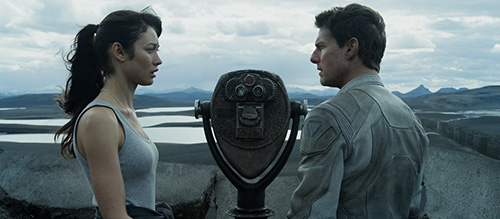Joseph Kosinski Movies Ranked
American filmmaker Joseph Kosinski burst onto the scene in 2010 with the most expensive feature directorial debut in history, Tron: Legacy (at a swift $170million of Disney’s money), and expectations were high for this new generation filmmaker, his comfort as regards working with CGI and confidence in taking up such a large project seemingly pointing him towards the top.
Over the course of the next decade or so, Kosinski’s career wouldn’t quite turn out to be hit factory that some may have expected, lacklustre Tron box office returns setting back any plans for a sequel and other projects failing to land critically or commercially as some may have hoped.
Over this period, the director of exclusively American films bonded with a number of major actors however, his all-star casts creating a list of talented and highly sought after individuals with whom Kosinski would collaborate across multiple projects. Experienced A-Lister Tom Cruise, awards favourites Jeff Bridges and Jennifer Connelly, and his most-used on-screen collaborator Miles Teller – with whom he’d make Only the Brave, Top Gun: Maverick and Spiderhead – each showed a willingness to work with this relatively inexperienced filmmaker from project to project, perhaps sensing the talent beneath the hype.
Joseph Kosinski is no longer a hot up-and-comer, his name now attached to a billion dollar movie and his filmography beginning to stack up, but the same can not be said of his filmmaking style. This is a director with uniquely modern Hollywood sensibilities, for whom spectacle is largely focused upon, for whom actors hold the key to connecting to the audience, for whom pushing the limits of technology and looking for new ways to make a film are seemingly more important than the stories being told. He’s a filmmaker you’d expect is inspired by Steven Spielberg and Ridley Scott rather than arthouse fare or more hard-edged filmmaking. He’s a filmmaker with a lot in common with James Cameron and Top Gun’s own Tony Scott.
In this edition of Ranked, we at The Film Magazine are looking at each of Joseph Kosinski’s barrier-stretching, CGI-fused, and often divisive, expensive contributions to cinema to rank each from worst to best in terms of overall quality, artistic intent, cultural significance and popular appeal. These are the Joseph Kosinski Movies Ranked.
Follow @thefilmagazine on Twitter.
5. Spiderhead (2022)

An interesting concept with tonnes of unrealised potential, Joseph Kosinski’s streaming debut Spiderhead was the below-standard follow-up to Top Gun: Maverick that perhaps slowed some of the director’s momentum and reminded people of the more divisive end of his filmography.
The major issues with this Netflix Original arose from the script, which seemed unable to focus on either Miles Teller’s prisoner or Chris Hemsworth’s scientist, instead getting lost in attempting to serve both and therefore leaving itself absent of a defined perspective. It was the case across the board that there seemed to be little by the way of purpose, Spiderhead playing like a less-imaginative episode of ‘Black Mirror’; a thought experiment lacking the depth and philosophies necessary for a feature film.
Spiderhead was also by far the worst-looking project of Kosinski’s career to date, the film taking on two visual death knells in the shape of Netflix’s required colour grading and overall glossy look, and the empty sets and badly stitched together scenes forced by filming with the restrictions of the pandemic.
There was so little of Kosinski’s standout directorial trademarks on offer here too, Spiderhead being an almost unrecognisable entry into his cinematic canon and an undoubted blotch on the overall output of this talented filmmaker.
Recommended for you: Todd Phillips Movies Ranked
4. Oblivion (2013)

Working from one of his own long-gestated screenplays that had been developed into an unpublished graphic novel, adapted into a screenplay by somebody else, and then passed around Disney and Universal, Joseph Kosinski solidified the most obvious traits of his filmmaking style in 2013’s Oblivion, tying the rhythmic sensibilities and high contrast imagery of Tron: Legacy to another high concept, massive-budget ($120million), science fiction film with an A-List lead, this being the first of his collaborations with Tom Cruise.
Oblivion was very similar to Kosinski’s other work in how it used widely relatable themes of romance, love, and bonds, and explored them within a high concept suited for CG landscapes and graphically-fused visual canvases. This film was set on post-apocalyptic Earth, now a shadow of its former self with humanity all-but removed from its landscape, the remnants of our collective presence poking out from the sand dunes and forests just as old memories would return for Tom Cruise’s Earthbound mining operative. As was the case with other Kosinski films, some elements of the story were cliché and the vast majority of creativity was reserved for how the film looked and how the crew shot it rather than for the story itself, though Oblivion at least attempted something relatable and honest during an era in which science fiction films seemed to be getting increasingly worse.
Unfortunately for Kosinski, 2013 also came in the midst of a downturn in popularity for lead Tom Cruise, meaning his film needed more than a creative concept and shareable imagery to gain an audience. The film would ultimately make $286million at the global box office – not enough to cover its production and advertising budgets – succumbing Kosinski to a second critically divisive box office flop in a row, the opening two films of his career no less. All of Kosinski’s potential was quickly being erased by a relative failure to make profitable movies.
In retrospect, Oblivion is more interesting than it may have appeared at the time, but it remains a relatively underwhelming entry into Joseph Kosinski’s filmography; a movie that showed off more of what this filmmaker could achieve whilst offering little by the way of directorial signatures for fans and studios, to latch onto.

